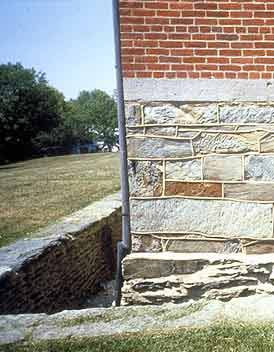


| Materials | |
| Craft Details | |
| checklist |
ASK
Does this "up close" view of a building wall reveal something
special about the surface qualities of the historic materials – their
variety and arrangement and the way they have been worked? Yes.
LOOK + IDENTIFY
The bottom of the building walls are formed of large pieces of broken
stone with raised mortar joints. The wall just above is made up of roughly
rectangular stones that vary in size, color, and texture. Above that is a narrow band of cut and dressed stones with thin mortar joints.
Finally, the main building walls are composed of bricks, uniform in color,
with fairly generous mortar joints.
WHAT IF THE MATERIALS ARE ALTERED? The arrangement and variety of materials (and of course, the craftsmanship) are essential to this building's historic appearance. Changing the raised mortar joints, for example, would drastically alter the visual character at arm's length.
WHAT SHOULD YOU DO?
Preserve character-defining exterior materials in the process of rehabilitating a historic building for a continuing or new use!